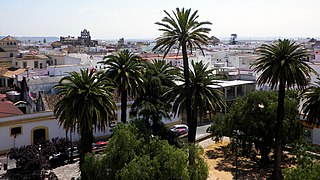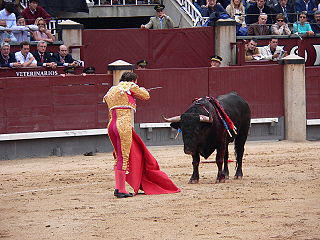
The festival of San Fermín is a week-long, historically rooted celebration held annually in the city of Pamplona, Navarre, Spain. The celebrations start at noon on 6 July and continue until midnight on 14 July. A firework (Chupinazo) starts off the celebrations and the popular song Pobre de mí is sung at the end. The most famous event is the running of the bulls, which begins at 8 a.m. each day on 7–14 July, but the festival involves many other traditional and folkloric events. It is known locally as Sanfermines in Spanish and Sanferminak in Basque, and is held in honour of Saint Fermin, the co-patron of Navarre.

A running of the bulls is an event that involves running in front of a small group of bulls, typically six but sometimes ten or more, that have been let loose on sectioned-off streets in a town, usually as part of a summertime festival. Particular breeds of cattle may be favored, such as the toro bravo in Spain, also often used in post-run bullfighting, and Camargue cattle in Occitan France, which are not fought. Bulls are typically used in such events.

El Puerto de Santa María, locally known as El Puerto and historically in English as Port Saint Mary, is a municipality of Spain located on the banks of the Guadalete River in the province of Cádiz, Andalusia. As of 2016, the city has a population of c. 88,184, of which some 50,000 live in the urban center, and the remainder in the surrounding areas.

A bullring is an arena where bullfighting is performed. Bullrings are often associated with the Iberian Peninsula, but they can also be found through Iberian America and in a few Spanish and Portuguese ex-colonies in Africa. Bullrings are often historic and culturally significant centres that bear many structural similarities to the Roman amphitheatre.

El Fandi is statistically one of the most skilled matadors in the world. Currently, he is ranked number one among all bullfighters in Spain.

Algemesí is a municipality in the comarca of Ribera Alta in the Valencian Community, Spain.
Christian Montcouquiol was a French matador.

Bullfighting is a physical contest that involves a bullfighter attempting to subdue, immobilize, or kill a bull, usually according to a set of rules, guidelines, or cultural expectations.

Feria del Sol, or Carnaval Taurino de America, is an international cultural festival held in the city of Mérida, Venezuela every February of the year. The Feria festival is held alongside the carnival feast. The festival includes bull competitions, cultural expositions, commercial and zootechnic expositions, concerts, parades, sports, and a voting competition for La Reina Del Sol.

The Feria de Agosto or Feria de Málaga takes place every August in the city of Málaga, Andalusia, Spain.
José Humberto Eslava "Pepe" Cáceres was a Colombian bullfighter. Born in Honda, Tolima, Colombia, he is often regarded as one of the finest bullfighters ever and the best-known bullfighter Colombia has ever produced. He was also a breeder of bulls and bullfighting organizer.

Julio Aparicio Díaz, also known as Julito Aparicio, is a Spanish bullfighter from Seville. Aparicio made his public début in bullfighting at the age of fourteen in 1984. He was confirmed as a torero, or matador, in 1994.

The Royal Fair of Algeciras is the most important annual festival in the Spanish city of Algeciras, held in June each year. Since it was established in 1850 as a cattle market, the fair and the fairground in which it is held have become popular attractions for the people of Algeciras and the surrounding towns of the Campo de Gibraltar. It has moved several times since its establishment and is now held in the Las Colinas area, where Algeciras's Las Palomas bullring is also located.

La Malagueta is a bullring at Málaga, Andalucía, Spain. It is located in the eastern district of Málaga, in its namesake neighbourhood of La Malagueta.
Plaza de Toros de Manizales is a bullring located on its homonym city, in the center of Colombia. It's currently used for bullfighting during the Annual Fair of Manizales in January, musical events and sport events to a lesser extent.

The Feria de La Línea, also known as La Salvaora or La Velada is a Feria (festival) and one of the most important celebrations in the Spanish municipality of La Línea de la Concepción.
The Feria Real de San Roque, known as the Royal Fair of San Roque in English, is San Roque's main street fair, held on the second Tuesday of each August. It is located in the El Ejido fairground.

The Alliance Anticorrida is a law association founded in May 1994 in Nîmes which works for the abolition of bullfights, the suppression of injuries and mutilations inflicted on animals used during bullfighting shows, and the protection of minors.

The Plaza de Toros de Pontevedra (Spain) is the bullring of the Spanish city of Pontevedra and the only one in the autonomous community of Galicia. It has a capacity of 7,800 spectators and is classified as the second category of Spanish bullring. The current bullring replaced a wooden one dating from 1892, although the tradition of bullfighting in Pontevedra dates back to the 17th century.

Fuengirola Bullring is a 3rd category bullring located in Fuengirola, a coastal town in the province of Málaga, part of the autonomous community of Andalusia, Spain. The plaza is known for hosting traditional bullfights, as well as other cultural and entertainment events, such as concerts, theatrical performances, and exhibitions. It serves as an important venue for cultural exchange and a symbol of Spanish tradition and history.
















